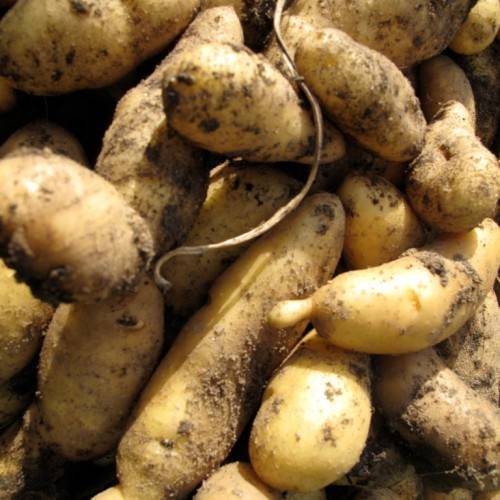
potato
Solanum tuberosum
Cycle:
Annual
Watering:
Average
Hardiness Zone:
2 - 11
Flowers:
Flowers In Summer
Sun:
full sun
Fruits:
Fruits Ready In Fall
Edible:
Yes
Leaf:
Yes
Growth Rate:
High
Maintenance:
Moderate
Drought Tolerant:
Yes
Salt Tolerant:
Yes
Indoors:
Yes
Care Level:
Medium
watering
Potatoes (Solanum tuberosum) should be watered regularly in order to grow and produce a good harvest. In general, potatoes need about 1 to 2 inches of water per week, either from rainfall or from irrigation. This amount should be spread out over a couple of waterings (assuming you don’t get steady rainfall). Early in the season, potatoes need more frequent, light waterings. Once the plants have set their fruits, watering can be reduced to once a week, or every other week. Deep, story waterings are not recommended—potatoes prefer gentle, even irrigation. Make sure the soil doesn’t dry out between waterings, and be sure to adjust your schedule if you get heavy rains or a very hot, dry spell.
sunlight
Potato plants (Solanum tuberosum) require a minimum of 5-6 hours of direct sunlight daily for optimal growth and development. Sunshine exposure during midday when direct sunlight is most intense is especially beneficial. However, too much direct sunlight can cause burning of the leaves, so it’s important to provide a medium level of exposure throughout the day.
pruning
Pruning should begin as soon as the plants are 5-7 cm in height, and should be done every 2-3 weeks throughout the growing period. Specific pruning guidelines will vary depending on the potato variety, where it is growing, and the climate. When it comes to pruning, the main goal is to remove excess foliage. This helps to improve air circulation and sunlight exposure, which promotes healthy growth and fruit production. To prune potatoes, use pruning shears to remove any foliage that is more than 15 cm from the main stem of the plant. This will also help to encourage lateral branching and a fuller plant canopy. Always be sure to use clean, sharp pruning shears and sanitize them between each use to avoid the spread of disease. Pruning should be done in the morning, as late afternoon pruning can encourage disease and pests. And remember—pruning may be necessary for potato plants, but it shouldn’t be overdone. Too much pruning can reduce yield and cause stunted growth.
Season
Hardiness Map
FAQ
Do potato plants need a soil pH level?
Potato plants do need a soil pH level in order to grow properly. The optimal pH range for potato plants is between 4.5 and 6.5. If the pH of the soil is within that range, potatoes can absorb a full range of essential nutrients that are required for optimal growth and health. If the soil pH is too high or too low, though, then deficiencies in some essential nutrients may occur, which can stunt potato plant growth. Therefore, it is important to test the soil's pH level before planting potatoes in order to ensure optimum growth.
Is it essential to mulch soil around potato plants as they grow?
Yes, it is essential to mulch soil around potato plants as they grow. Mulching provides several benefits to the potato crop, with the most important being to protect the soil and its root system from rapid temperature changes, conserve moisture, and reduce weed growth. It also helps to reduce soil erosion, further protect potatoes from disease, and can help to prevent potato blight. Additionally, when compost or organic matter is used in the mulch, it can also help to add nutrition to the soil and provide a better growing environment for the potato plants.
Are potato plants able to tolerant frost?
Potato plants are able to tolerate frost to a certain degree. Under some conditions, the leaves of the plant may suffer damage or even die if temperatures dip below 32°F and stay low for an extended period of time. The tubers of the plant are slightly hardier and can be buried several inches deep in the soil, where the ground can provide some insulation against the cold. With a little diligence and care, a potato plant can be a surprisingly cold-resistant crop, particularly in temperate climates.
Do potato plants require support by staking them?
Yes, potato plants typically require support from staking them, as they generally grow tall and have weak stems. Staking helps the plants to grow upright and keep the leaves and stems away from the ground. Stakes also make it easier to harvest the potatoes, as they can be found snuggled between the seed-piece and stem. Stakes should be at least 2 feet tall, and a variety of materials can be used, including bamboo, wooden stakes, or metal rebar. It is important to drive the stakes directly into the soil and ensure they are securely pounded in so the potato plants can receive the stability support they need.
Do potato plants produce seeds for propagation?
Yes, potato plants produce seeds for propagation. Potato plants produce what are known as 'true potatoes', which are composed of several small berries (fruits) and each berry contains several hundred small, hard seeds. Collecting the berries and setting them aside for dry can provide an effective way of propagating potatoes year after year. For best success, it is recommended that the berries be left in a cool, dark place until the seeds are ready for sowing the following Spring.
